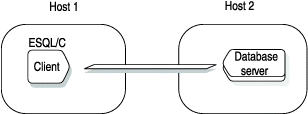The client-server architecture of ESQL/C applications
When the program executes an SQL statement, it effectively passes the statement to a database server. The database server receives SQL statements from the database application, parses them, optimizes the approach to data retrieval, retrieves the data from the database, and returns the data and status information to the application.
The program and the database server communicate with each other through an interprocess-communication mechanism. The program is the client process in the dialogue because it requests information from the database server. The database server is the server process because it provides information in response to requests from the client. The division of labor between the client and server processes is advantageous in networks where data might not be on the same computer as the client program that needs it.


- Identify database server connections that have been defined for the client-server environment of the application
- Execute an SQL statement to connect to a database server